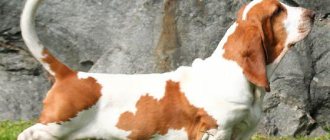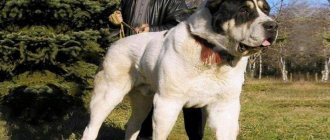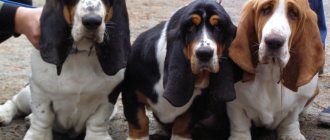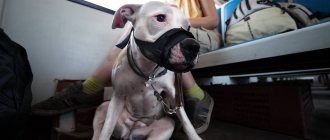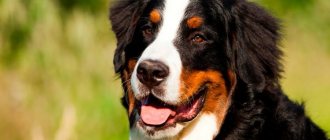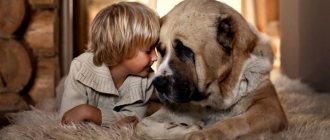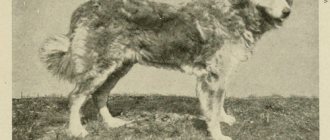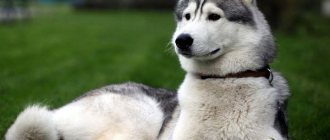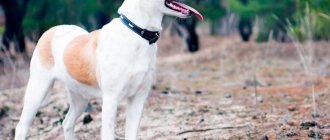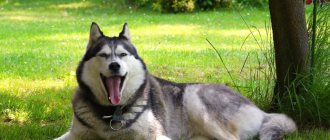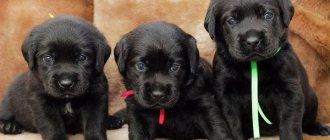Care and maintenance
Long ears require special attention: daily inspection for insects and debris, cleaning with cotton swabs once every 2-3 days.
After bathing, the ears must be dried. The eyes are washed with chamomile infusion once a month and wiped with cotton swabs to prevent tears.
It is also important to monitor the condition of skin folds: remove debris and dust. If there is excessive drooling, the face should be wiped with paper towels.
Nutrition
To prevent your dog from becoming obese, your pet needs a strict diet.
As with other breeds, the presence of three components is important for Bassets:
- Proteins;
- Cereals (porridge, cereals);
- Vegetables and fruits.
The basis of the diet should be low-fat fermented milk products (cottage cheese, kefir), raw and boiled chicken, turkey and beef, eggs (2-3 times a week)
It is important to give your pet liquid food (broths, soups) and jellied meats to strengthen joints and cartilage tissue
These dogs never get full, so you should limit your food intake to two times a day. Puppies are fed more often - 5-6 times a day. Serving size is calculated using the formula: 20% of the puppy’s weight. You should not feed your Basset Hound from the table; this bad habit negatively affects digestion and is very difficult to wean from it.
The recommendations are similar when feeding dry food. You should choose only among super premium baits. Mixing natural products and dry food is not recommended.
Health
Genetically, Bassets are predisposed to many diseases of the spine and joints. They should not be overloaded by jumping and climbing steep stairs; the weight and condition of the limbs should be monitored.
Their immunity is quite strong, but this does not exempt them from timely vaccination.
Vaccinations
Vaccination is carried out in designated places - veterinary centers and clinics under the guidance of experienced specialists. You cannot do vaccinations yourself. The price of the medicine varies from 450 to 1500 rubles, depending on the drug and its purpose.
There are two main vaccines accepted for dogs:
- Complex vaccination against enteritis, leptospirosis, plague, influenza, salmonellosis, hepatitis. The first one is done at 1.5-2 months, and repeated after 2-4 weeks. Then at 6 and 12 months, and then annually.
- Rabies vaccination (required for export abroad). Vaccination is carried out at 6-7 months and is updated annually.
Diseases
- With a lack of calcium, excessive exercise and poor nutrition, the Basset Hound develops knee and hip dysplasia (a deformity that causes discomfort and pain when moving).
- Another disease characteristic of puppies is panostitis (lameness caused by internal inflammation).
- In addition to sore joints, Bassets often have eye problems due to excessive tearing and skin folds: glaucoma, cataracts, conjunctivitis. Most often they are inherited.
- Eating disorders, intestinal and stomach volvulus, diarrhea, obesity - all are associated with poor nutrition. Problems can be solved with medication or surgery. Basset hounds are allergy sufferers. Reactions can occur from plants, consumer products, shampoos and cosmetics.
- Dogs suffer from dermatitis and skin diseases due to clogged pores. They require special care for folds. Otitis and inflammation of the ears are common. There are genitourinary diseases: kidney stones, sand. With proper feeding, the risks are minimal.
- Another pathology is von Willebrand disease (reduced blood clotting). It is inherited and manifests itself as the dog ages.
Walk
After the second vaccination, the puppy can be walked
It is important not to limit his communication with people and other pets. It is worth accustoming to a leash and collar, to discourage the desire to break free and run away
Little Bassets are not recommended to walk for longer than 10-15 minutes; in adults, walks can be increased to 1 hour.
Basset hounds love active games: chasing the ball, frisbee, racing, searching for objects.
Grooming
- This breed has short hair, but it requires enormous care. Due to their short limbs, Bassets get dirty all the time, since they cannot be bathed often (2-3 times a month); they need to wipe their fur and skin with a damp cloth or special napkins. In damp and cold weather, your pet should be dressed in protective suits.
- These dogs are prone to active shedding. It is advised to purchase a comb-mitten and comb your pet with it 2-3 times a day.
- In warm weather, it is customary to treat Bassets against fleas and ticks with special oils, or to put a protective collar on the dog.
Content Features
The Great Vendeen Basset Griffon is a sociable and very social dog that can theoretically live outside all year round, but not alone, perhaps in the company of other dogs. A more suitable option for her would be to keep her in a private home, as a family member. BVBG adapts to life in an apartment; in this case, walking should be daily and last at least 1.5-2 hours. Poorly trained and disobedient dogs should not be let off leash.
The large Vendean Basset Griffon is a playful and energetic dog. To maintain good health and physical fitness, you need long walks, regular trips to the forest, and the opportunity to realize your hunting instinct. Care
The large Vendean Basset Griffon requires regular grooming. If all recommendations are followed, the owner will be able to avoid problems associated with shedding, and the dog will always look well-groomed and neat.
- It is recommended to comb 2-3 times a week.
- Trimming is indicated every 2-3 months.
- Wash with coat type-appropriate shampoo as needed.
- Nails are trimmed every 3-4 weeks.
- The auricle is cleaned and the fur inside is removed.
- The fur between the paw pads is trimmed.
- Teeth brushing weekly.
Care and maintenance of the Belgian Griffon
The breed is demanding in terms of comfort and temperature conditions in the room. The Belgian mini-griffon breed was introduced and should have its own corner - a place where they will relax, there will be a comfortable bed and toys. Caging is recommended only for educational purposes for destructive behavior.
The dog needs regular walks in the fresh air with active games, but it is important not to overexert the baby. Caring for a Belgian Griffon includes the following procedures:
- hair trimming;
- regular combing with a comb;
- bathing is rare;
- paws are washed after every walk;
- examine ears and eyes once a week;
- Nails are shortened monthly;
- Teeth brushing is done every week;
- After feeding, the face is cleaned with a damp cloth.
https://youtube.com/watch?v=F5yA225PM8U%250D
What to feed your Belgian Griffon?
The breed is prone to overeating, so it is important to accurately count food. In addition, veterinarians recommend strictly following the daily routine so as not to cause digestive problems.
Belgian Griffon diet:
- up to 1.5 months – 6 times a day;
- up to 3 months – 4 times a day;
- up to 6 months – 3 times a day;
- from 7 months - 2 times.
The most affordable and simple food basket is ready-made food and canned food. In order to be completely confident in the quality, it is recommended to purchase premium products. Belgian Griffon puppy and adult dog will happily eat food from the following brands: 1st Choice Breeders, ProNature Holistic, Orijen Original. Having chosen a natural diet, you need to include the following products:
- lean meat;
- sea fish;
- rice or buckwheat;
- low-fat cottage cheese, kefir and sour cream;
- vegetables and fruits;
- vegetable oil.
Prohibited products include:
- fat meat;
- sweets and baked goods;
- smoked meats and pickles;
- pipe bones.
Do Belgian Griffons need clothing?
The breed is a heat-loving breed, so in the cold season it is recommended to buy them a warm wardrobe. Clothes should be of high quality, not restrict movement, not cause any discomfort, allow you to run around and relieve yourself naturally. The shorthaired Belgian Griffon will appreciate the following wardrobe:
- warm sports suit;
- insulated raincoat;
- knitted sweater.
Belgian Griffon trimming
The essence of the procedure is to pluck out dead hairs. Thus, the old fur is removed. The Belgian Griffon dog is trimmed using a special device or manually. To keep everything simple, it is recommended to accustom your dog to the procedure from an early age. They begin at the age of 3 months, doing “plucking” on the neck and body. The first full trimming is carried out upon reaching 6 months. The procedure goes as follows:
- the dog is well combed;
- movements are carried out from the withers, moving towards the tail;
- then proceed to the sides and paws.
People unfamiliar with the breed are interested in whether the Belgian Griffon sheds. There is no natural process, so the breed needs to be helped to get rid of dead hairs. Dogs that take part in exhibitions require a similar procedure every 3-4 months, for the rest, twice during periods of natural molting of animals is enough.
It is important to know that you can only pluck long hairs, completely ignoring the undercoat. This part of the coat must not be cut, plucked or shaved.
Appearance
The large Vendean Basset Griffon is a long-form dog with straight, short legs, a long tail and coarse hair. Contrary to its name, the BVBG is not large, it is a medium-sized dog, the same height as a cocker spaniel or beagle, only noticeably longer, stronger and heavier than these dogs. Sexual dimorphism is pronounced.
- Height: 39-44 cm.
- Weight: 15-20 kg.
The Great Vendean Basset Griffon is very similar to the Lesser Vendean Basset Griffon. The main difference is in size, but it also has a longer muzzle, ears and tail.
The skull is elongated, rounded, not very wide. The stop is noticeable. The muzzle is square. The nose is prominent and black (brown only in red and white dogs). The lips are drooping, the upper one covers the lower one. The eyes are oval, large, dark in color, the conjunctiva is not visible. The ears are narrow, thin, ending in an oval, turned inward, set below eye level. Neck without dewlap.
The body is not overly long. The back is straight, the lower back is strong, slightly convex. The chest is wide, dropped to the elbows. Groin filled. The tail is saber-shaped and quite long. Limbs with developed bones and muscles, strong. Paws are strong, well-knit with hard nails and durable pads.
The coat is coarse, hard, not very long, straight. The undercoat is well developed. Eyebrows do not cover the eyes. Colors:
- Two-colored (white with black spots, white with red spots, black and tan, fawn or fawn with a black touch).
- Tri-color (Black and white with tan, fawn or fawn with black patina and white spots).
Maintenance, care and nutrition
The animal can live in a house or apartment. You need to walk your dog every day, as it needs a lot of physical activity. The best conditions for this would be a house with a garden plot. The best option would be a walk in nature, where the hunting dog fully realizes its needs for movement. Much attention should be paid to the content of the animal’s fur:
- It needs to be constantly combed, and also groomed and trimmed once every 2 months so that the coat does not shed too much.
- This is also necessary because debris is retained in the hard hair shaft.
- You need to bathe your dog no more than once every 2 months.
- You need to regularly care for your animal's ears and eyes. Inspect, dry, clean the ears, pluck the fur inside them. Wipe your eyes. You should choose thorns from the wool and fight parasites.
The dog needs to be fed meat, giving it at least 200 g per day. Animals of this breed love offal. To assimilate food, they add cereal and vegetable soups, protein and plant foods. There is no need to boil dog bones.
Health of Vendean Griffons
The life expectancy of the Vendeans is 12–14 years.
But in order for the dog to live as long as possible, it is important to monitor its health. The most common diseases among representatives of this breed:
- ear infections, otitis media (occurs when the dog’s ears are not properly cared for);
- hypothyroidism (underfunction of the thyroid gland);
- dermatitis (occurs due to improper care of the dog’s skin and coat);
- epilepsy (may be a consequence of injuries that these dogs often receive during active games);
- persistent pupillary membrane (congenital anomaly of the iris).
Due to its activity during games, the dog can receive wounds, bruises, dislocations, and fractures.
It is important to monitor how the animal behaves. If it suddenly becomes passive, whines, or limps, then you should immediately show it to the veterinarian
It is recommended to carry out preventive examinations with a doctor at least once every six months - this will allow you to promptly identify pathologies in the first stages and immediately eliminate them, without waiting for complications.
Character
Griffons, despite their decorative appearance, were originally rat-catching dogs - the ancestors of the breed were agile and agile small dogs that lived near stables and whose task was to catch rats. To this day, the breed has not lost its passion and working qualities.
Left alone, griffons tend to sleep soundly, in this respect they resemble cats. But if they get bored, like any dog, they can become involved in sabotage during puppyhood. Therefore, it is worth providing your pet with a variety of toys.
Griffons are very smart. They quickly learn the rules of living in the house, the habits of the owners and adapt remarkably well to them, demonstrating their best qualities. Thanks to this, they are able to quickly win the hearts of every family member. The breed is very sociable and needs constant contact with its owners.
Griffons are thinking dogs, humanly intelligent. They assess the situation and plan their actions several steps ahead. Males are more straightforward, “girls” are more cunning. These kids will not miss out on their benefits.
Griffons get along well with other animals, including cats and parrots. However, some individuals can hunt birds or small animals. The hunting instinct in them is still well developed. But if the puppy grows up in a house with other animals, there are no problems.
The Griffon is peaceful, but if it gets into a fight with another dog, it will not yield.
Griffons get along well with children and play happily with them.
Aggression or cowardice are not typical of griffons. Manifestations of these qualities are a marriage.
Griffons are clean dogs, but the degree to which this quality is expressed depends on individual characteristics. There are dogs who would never agree to get their paws wet in a puddle, while others are ready to run happily through the mud.
Some griffons snore in their sleep, and sometimes the volume of their roulades can rival that of longshoremen.
In their youth, griffons are very active, ready to rush from morning to evening. With age they become calmer and more reasonable.
Griffons tolerate the road well and usually sleep on the way. The main thing is to protect them from overheating at extremely high temperatures or from hypothermia at low temperatures.
Griffons are emotional and do not hide their feelings. They have very expressive facial expressions; literally all the nuances of their mood are reflected on their faces.
However, do not forget that each dog has its own character. Moreover, the griffon, which is the only pet in the family, behaves completely differently from griffons that live in a “pack”.
History of the breed
Hunting with hounds became popular among European nobility in the Middle Ages. France was the epicenter of cultural life; each region had its own breeds of hounds.
In the Vendée (west of France), there was a large Vendéan basset griffon (French: Great Vendée Basset Griffon). The exact origins of the breed are unknown and are unlikely to ever become known.
The version says that the great Griffon descended from black hounds, or from the extinct Roman hunting dogs. Over time, he bred with other breeds, and the order came to us changed.
For most, the Small Basset Griffon Vendeen is similar to the Large Basset Griffon because they share the same ancestors. However, it is smaller, smaller, shorter muzzle, and often bow-legged, not like the large Vendean Basset Griffon.
In 1950, separate standards were created for both species, although inbreeding continued until 1975.
At the moment, this is one of the most famous French hounds, very common in other countries. In the US there is the Petite Vendeen Basset Griffon Club of America, founded in 1984, and the AKC recognized the breed in 1990.
In 1992 he joined the United Kennel Club. Although the breed's popularity is growing, it is still rare, including in the countries of the former Soviet Union.
Basset griffon vendeen - breed standard, varieties and character of the Vendeen
There are two subspecies in the breed; for a long time they were separated only by size. Later, the characteristics of each of them were derived.
Usage
Vendeans are considered natural hounds and are known for their speed, swiftness and endurance.
During a hunt, they can pursue prey for several hours, moving either alone or in a group. In addition to their main use, many fanciers keep them as a companion: pets are distinguished by their intelligence, intelligence, and good attitude towards people.
Grooming before the show
Appearance
The large Vendeen griffon, like its smaller brother, has a slightly elongated body and is somewhat reminiscent of a basset hound. Its main characteristics are elegance and lightness.
The description of appearance contains the following characteristic features:
- head - with a rounded, not too wide skull, well-developed occipital protuberance;
- muzzle - longer in large representatives than in small ones;
- lips - slight drooping gives the muzzle a more square shape;
- eyes - oval-shaped, large, dark in color;
- ears are of medium size, hanging type, with a thin flap that turns slightly inward; in large representatives the ear protrudes beyond the tip of the nose, in small ones it does not reach;
- neck - medium length, strong and strong, without visible dewlap;
- body - with a straight and large top, wide croup, wide and deep chest;
- tail - saber-type, without curling into a ring, medium length, thick at the base;
- paws - proportional to the body, massive, hock joints have a good angle;
- height - large individuals grow up to 39-44 cm, small Vendean basset griffons - do not exceed 34-38 cm;
- body weight - the weight of an adult varies from 11 to 18 kg.
The coat is dense and coarse, with no undercoat or soft downy hair underneath. The RFK criteria allow several colors of dogs:
- black with red or light red tan markings;
- white-black or black-and-white version;
- white-fawn shade;
- sandy with white splashes and slight blackness.
Important! A large number of different colors allows you to choose the cutest puppy for yourself.
Characteristics of the Vendean Basset Griffon breed
The pack after the hunt
With proper training, dogs become ideal companions. If training time is missed, the animals develop many disadvantages, including unrestrained activity.
Pride and independence, multiplied by a lack of upbringing, often becomes the reason for attempts to dominate in the family. If the owner shows weakness, the pet will not obey and will try to insist on its own. He believes that he has the right to manage his own life and decide what and when to do.
Natural hunters can perceive any suitable object as prey, chase it down or attack it. The desire to protect the owner can result in attacks on passers-by or people who come close.
Important! Their stubborn disposition allows pets to sleep anywhere, choose their own food and chew on any things. Accustoming to order and discipline should begin from tender puppyhood.
What is attractive about the breed, its disadvantages
The positive qualities of dogs include:
- easy adaptation to living in urban environments - apartments and private houses;
- contact - with proper upbringing, the animal gets along easily with the owner, follows commands and does not show aggression on the streets;
- fidelity - the pet will protect all family members, keep company for both adults and children;
- high intelligence - four-legged animals understand the mood of the owner, react to gestures and facial expressions;
- courage and bravery - the dog does not try to escape from offenders, is able to stand up for itself, and does not take last place in the pack.
Capable of running away while walking
Experts include the following among the features and disadvantages of the content:
attempts to catch up with mice, stray cats and dogs during walks - the basic hunting instincts are strong in her; may run away if found outside without a leash or not respond to given commands; capable of starting a conflict with children who carelessly pull her fur or ears; is capable of destroying a domestic hamster or guinea pig, considering it worthy prey.
Important! The dog is capable of being offended - he understands perfectly well when he is scolded. When taking responsibility, the owner must constantly monitor the behavior of his pet.
Breed Vendeen Basset Griffon (large and small)
Breed standard: Large and small Vendeen basset griffons have breed standards FCI No. 33, No. 67, which were adopted on February 14, 2001.
Breed classification: Group 6. Hound dogs, blood trail hounds. Section 1.3. Small hounds. With working tests.
Peculiarities of the breed: basset hounds are small dogs, very agile, lively, with a strong, slightly elongated body.
The head is expressive, round, slightly elongated, with clear outlines under the eyes and a convex occipital protuberance. The nose is prominent, with wide open nostrils of a black hue. The muzzle is square and does not taper toward the nose. In the large basset it is longer than in the small one and has a slight hump. The lips are drooping, completely covering the lower jaw and giving the muzzle a square shape. The jaws are well developed and have a scissor bite. The eyes are oval and large. The iris is always dark in color and completely covers the whites. The expression of the eyes is intelligent, friendly, welcoming. The eyebrows are directed forward, but do not cover the eyes. The ears are narrow, thin, elastic, rounded at the end, set below eye level, and covered with long hair.
The neck is strong, long, and muscular. The back is wide, straight, with a slight convexity in the lumbar region. The loin is strong, muscular, convex. The chest is wide, deep, reaching the level of the elbows. The ribs are round, not flat, not barrel-shaped. The stomach is not tucked in.
The tail is set high, thick at the base, tapering towards the end, slightly curved, but without a hook at the end. The forelimbs are straight, the shoulder blades are long, oblique, and dry. The elbows are located at a moderate distance to the body. The hind legs are strong. The thighs are muscular and rounded. The hock joints are wide, but not fully straightened. The paws are strong, the pads are dense, well pigmented, the toes are tightly closed. The skin is thick, and in tri-colored individuals it has a marbled tint. The coat is of medium length, thick, harsh, without softness or shine. The belly and inner thighs are covered with fur.
The Vendean Griffon has a black coat with white and black spots.
In addition, black and tan, black and light tan, fawn with white and white and orange spots, pale fawn with black patches and other shades are acceptable.
Height of the Small Vendean Griffon (both males and females): 34 – 38 cm.
Height of the large Vendean Griffon: males – 40 – 44 cm; females – 39 – 43 cm.
The dog's weight reaches about 20 kg.
Brief historical background
There are several versions of the origin of griffins. According to one of them, the ancestors of these small funny dogs were dogs called smousje, who lived in peasant farms in the vicinity of Brussels several centuries ago (14-15 centuries) and were engaged in the extermination of rodents (rats and mice), which were found in abundance in barns and granaries. The animals had a narrow, long muzzle, which helped them cope with their responsibilities better. The infusion of pug blood made them more miniature and aristocratic.
Some researchers believe that the Brussels was the result of deliberate crossing of Affen Pinschers with spaniels or wild Belgian dogs. Others believe that, on the contrary, German pinschers descended from the ancient griffons. There is an opinion suggesting the presence of an admixture of Yorkshire and Irish terrier blood. One way or another, cynologists came to an agreement in determining the exact date of the breed’s origin, believing that it appeared no later than the 30s of the 15th century. Some small dogs, extremely similar to modern Brussels griffins, were depicted on their canvases by painters of that time (Jan Van Dyck “The Arnolfini Couple”, 1434).
Artists often depicted dogs that looked like griffins in their canvases.
The first official appearance of griffons occurred in 1880 at the Brussels dog show, but they were called a little differently - the small Belgian wire-haired terrier. In 1904, the first breed standard was written and approved, which was finalized and supplemented in 1963. The latest valid version of the standard dates back to May 5, 2003, in the FCI registry Brussels Griffons are listed under No. 80 in Group 9 (Companion and Toy Dogs), Section 3 (Small Belgian Dogs).
History of the origin of the breed
Since the 14th century, dog fighting has been very popular in Japan. They were held to raise the morale of the samurai. This spectacular event spread throughout the country from the Principality of Tosa. In the 19th century, after changes in Japanese policy, when it became possible for foreigners to visit this country, dogs brought by Europeans also joined the dog fights. They were much stronger and tougher than Japanese dogs and usually won.
It became a matter of honor for the Japanese to develop a breed of dog that could give a head start to European dogs in battles, but at the same time correspond to Japanese concepts of the aesthetics of combat. Since 1860, active selection has been carried out in order to obtain a dog of outstanding physical and fighting characteristics, with an increased pain sensitivity threshold.
The new breed was based on the Bull Terrier and Akita. Over the years, blood flowed to them:
- bulldog;
- English Mastiff;
- German pointer;
- Great Dane.
Inbred breeding (closely related) was then carried out for three generations until the breeders were satisfied with the characteristics of the resulting individuals.
Tosa Inu was specially bred for dog fighting.
In 1964, the breed was recognized by the Fédération Cynologique Internationale (FCI), and the dog was also recognized by the American United Kennel Club (UKC), but this happened in 1998.
Outside of Japan, the breed is currently not widespread, and the Japanese themselves believe that the Tasa Inu in other countries is very different from the native dogs.
Origin story
Already by the middle of the 19th century, in the Vendee department, France, there was a group of similar wire-haired dogs that were used by local hunters to catch small game. They probably descended from the large Vendean hound, to which the blood of other breeds was infused. The Comte de Loys played a significant role in the development of the Vendean Basset Griffons. Under his leadership, targeted breeding work began at the end of the 19th century. In 1922, standards were written for the three varieties of Vendean dogs that existed at that time: Vendean, Briquette and Basset.
The name of the breed reflects the characteristic features of the appearance and origin of the hound: “large” - indicates the size, but only in comparison with the small Basset Griffon, “Vendeen” - the place of origin; “basset” means a short dog, and “griffon” means that it is wire-haired. From the middle of the 20th century, the shortest dogs began to be selected from the Vendeen bassets. This is how a separate type was formed - the Small Vendean Basset Griffon. At the same time, height restrictions were introduced for large basset dogs (up to 44 cm), as a result of which the population was greatly reduced. In 1970, the 2 varieties were finally divided by size into two breeds: the Large Vendeen Basset Griffon and the Small Vendeen Basset Griffon.
There are four varieties of Vendeans: the Greater Vendean Hound, the Briquette, the Greater and Lesser Basset Griffons.
Usage
The large Vendean Basset Griffon is an excellent assistant for hunting with a gun. Suitable for small areas, not afraid of thickets and bushes. Of all the basset dogs, he is the fastest, very brave, persistent and passionate. During the chase, he does not pay attention to weather or water obstacles.
Vendeen Basset Griffonis prefer to hunt with a pack of other hounds. They track prey using scent. They hunt small fur-bearing animals, sometimes birds. With appropriate training, they can perform well in various sports: agility, freestyle, tracking.
Care and hygiene
It is not whimsical, it is not difficult to care for, it is important to do it regularly and carefully. The dog sheds little, but requires weekly brushing to remove old hair.
Excess hair between the pads should also be removed. Most attention should be paid to regular cleaning of teeth and ears.
The dog sheds little, but requires weekly brushing to remove old hair. Excess hair between the pads should also be removed. Most attention should be paid to regular cleaning of teeth and ears.
- Bathing: As your dog gets dirty, a simple wash of the paws and a dry coat will do for daily care. Use only special animal care products, do not use human ones.
- Wool: comb during the molting period - every day, with a special slicker brush. At normal times, 2 times a week, not with a hard brush with medium long teeth,
- Eyes and ears: remove excess discharge with a simple cotton swab, clean ears as needed, monitor the general condition. Avoid the appearance of redness, unpleasant odor and unusual discharge.
- Nails: cut 1 – 2 times a month with a nail clipper, accustom them from the age of the puppy, otherwise they will not work.
- Teeth: brush your teeth yourself with a brush attachment, give solid food, chew large cartilage, carrots and apples.
- Vaccinations and veterinarian: visit the doctor once every 6 months for an examination, regular vaccinations and vaccinations in accordance with the age of the pet. Treatment of wool against parasites, anthelmintic drugs.
- Physical activity: walking at least 2 times a day for an adult, 3-4 times a day for a puppy. Active running, games, playgrounds, activities with toys and just free walking.
Tosa Inu Training Basics
Tosa Inu puppies are very active and playful. At this time, they need to pay a lot of attention, while at the same time starting their upbringing. With age, the animal becomes calm and calm, but if time is wasted, the dog may develop a sense of permissiveness, which is very dangerous.
In fact, there is no need to train a puppy to guard the house, although many owners put this almost at the forefront. The instinct to protect the owner's property is so strong that the animal will continue to do this on its own. It is worth focusing in training on completely different, basic skills.
It must be said right away that you can train yourself only if you have extensive experience in raising fighting dogs. Otherwise, immediately contact a dog handler. You should exercise only in special areas, since you will have to let the mastiff off the leash.
The owner must immediately position himself as a leader. The dog will perfectly feel any uncertainty and relaxation and will strive to take a leading position himself. Therefore, only the owner himself must train the pet, but the dog trainer advises and shows how to do it correctly. Execution of commands from other family members is practiced only after the dog obeys the owner unquestioningly.
Tosa Inu quickly grasp what is required of them, but they are prone to stubbornness and making independent decisions. Sometimes the dog may seem slow. In fact, she heard the command perfectly well, but is considering whether it really needs to be carried out.
Training and socialization
After the puppy arrives at its new home, you will need to accustom it to the following:
- New place of residence and his nickname;
- A place to sleep and eat;
- Walking on a leash, wearing a collar, wearing a ring;
- Loud sounds;
- To strangers and animals;
- Go outside as often as possible, try to change your walking route;
- Get used to cars and the sound of busy streets.
As soon as the pet has become accustomed, begin training classes, the best time is 2 - 3 months. A reward system will be used, this could be: a treat, verbal praise, an expression of satisfaction from the owner. There is no need to scold or punish. Take the simplest commands to study, gradually increasing the load and duration of classes. The first commands are given clearly, with repetition and subsequent reinforcement, obligatory praise. What to teach:
- Place;
- It is forbidden;
- Sit;
- Ugh;
- Lie.
At the age of 4 months, the puppy will know the basics of training, and gradually obedience will become ideal. If the classes are regular, and the owner shows persistence and patience, by the age of 6 – 9 months the dog will begin to obey – ideal.
Not everyone can properly raise an animal; people with minimal experience are better off immediately contacting a specialist. You can go through the initial stage with a professional, and then continue learning on your own.
How to choose a puppy
First of all, you need to pay attention to the conditions in which the puppies live. This will tell future owners not only about the health of the pet, but also about the integrity of the breeder
A healthy puppy should be clean, well-fed and active. By the time of sale, he should already have a beard, so a pet without a beard is considered inferior. To save money, some owners prefer to buy dogs secondhand. In this case, the pets may not have a pedigree, but the puppy must receive its first vaccinations in any case.
You should inquire about the vaccination schedule and see if you have a veterinary passport. There you can also see whether the dog has been treated for parasites. Possible names for boys: Fred, Charlie, Nick, Dominic, Karl, etc. Nicknames for girls: Becky, Nicole, Ora, Leah, Gerda, etc.
Comparison of breeds
The Belgian and Brussels Griffon are both very similar dogs, which is why inexperienced dog breeders believe that they are varieties of the same breed. The main difference between them is the color of the coat. Brussels are predominantly red in color, while Belgians come in black and tan and black. Otherwise, the characteristics of the animals differ little.
The Brussels Griffon and the Miniature Schnauzer are both compact breeds, but the Miniature Schnauzer is larger: its weight can reach 7 kg. The breed has a wide variety of colors: from solid white to pepper and salt. In addition, animals differ in character and temperament. The Miniature Schnauzer is more friendly and can easily connect with small children, while the Griffon may react negatively to children's pranks. Also, German dogs have good guarding and watchdog qualities, which Brussels dogs lack.
Pros and cons of the breed
| + | – |
| Gets along well with children of school age and older | There is seasonal shedding |
| Can live peacefully with other pets | No security qualities |
| Does not require intense physical activity | Specific coat care required |
| Easily trainable | |
| Possibility of living in an apartment | |
| Suitable for agility |
Character and behavior
The large Vendeen Basset Griffon is a balanced, confident and sociable dog. From an early age he must be taught obedience. Training is based on praise, but does not exclude punishment. By nature, the Vendean is not overly sensitive or vindictive. He is smart, quick-witted, passionate, quite energetic and playful. Loves to stalk, explore and dig. He becomes very attached to all family members and gets along well with children if raised appropriately. Prefers not to be alone for long.
The character of the Vendean is stubborn and independent, but in general the dog is friendly and obedient, trying to please the owner. More suitable for experienced dog owners, active singles or families.
They easily adapt to environmental conditions and are loyal to others. They quickly adapt to the rhythm of family life. He can be a little mischievous, but not out of malice, but out of play. Gets along well with other pets. When communicating with strangers, he is not aggressive, courageous and open to communication. Some dogs perform good guard functions but are not capable of guarding. The large Vendean Basset Griffons have a strong hunting instinct. Owners should consider activities with their dog that will help them develop their natural potential, such as blood trail work.
Health and illness
The dog of this breed is distinguished by its strong physique and health. She did not have any pathologies noted. Other Griffon breeds suffer from herniated discs. But in this case this disease practically does not occur. Occasionally, problems related to wool occur.
Thick hair growing in the inner part of the ear falls off for a number of reasons:
- due to low ear position;
- its poor ventilation.
To prevent the disease, you must:
- Include preventive measures for cleaning the inside of the ear in your animal care system. The hairs from it must be carefully plucked, freeing the surface once a month.
- The problem comes from hair getting caught between the dog's toes. Due to its thickness, debris gets clogged in the gaps, causing injuries to the skin that lead to abscesses.
It is necessary to remove hair in these places so that debris that gets between the fingers does not provoke suppuration.
Abdominal wounds received during hunting have detrimental consequences. In such cases, the dog is placed on a blanket and immediately taken to a veterinarian.
Lifespan
Dogs spend a huge amount of energy while chasing an animal during a hunt. This leads to rapid wear and tear of their body. But with a balanced diet and quality care, their life expectancy is from 10 to 12 years, but can last up to 17.
The main causes of death of an animal are:
- oncological diseases (33%);
- wear and tear of the body (24%);
- heart disease (7%).
In order to avoid the early death of a dog, you need to buy it only in nurseries, where animals with genetic abnormalities or poor health are culled, and healthy ones receive vaccinations and are raised properly.
Health and life expectancy
The dog has good health by nature, but there are some predispositions to diseases:
- Impaired visual acuity, eye diseases;
- Otitis;
- Endocrine disorders;
- Diseases of the musculoskeletal system;
- Food allergies;
- Skin dermatitis;
- Diseases of the digestive system;
- Epilepsy and diseases of the nervous system;
- Formation of tumors of various types at a later age.
Average life expectancy: 12 – 15 years. With proper care, proper nutrition and sufficient exercise, the dog will live a long life.
Breeds from the same group
- Alaskan Malamute
- American Cocker Spaniel
- American Staffordshire Terrier
- English Setter (Laverack)
- Basenji (Nyam Nyam Terrier)
- Basset Hound
- Billy (Biya)
- Breton Spaniel (Breton Spaniel, Breton Epagnol)
- Burgos Pointer (Burgos Pointer, Spanish Pointer, Burgossky
- Griffon Vendée
- Weimar Pointer (Weimaraner, Weimar Brack, “Silver Ghost”
- Welsh Terrier
- Smooth Fox Terrier
- Blue Picardy Spaniel (Blue Picardy Spaniel, Epagnol
- Greyhound (English greyhound)
- Jack Russell Terrier
- Drentic Partridge Dog (Dutch Partshond, Dutch Pa
- Wire Fox Terrier
- West Siberian Laika
- Golden retriever
- Irish Wolfhound
- Irish Setter
- Irish Terrier
- Italian Bracket (Italian Pointer, Italian Setter, Italianska
- Cane Corso Italiano
- Keeshond, Wolfspitz
- Kishu (Kishu-inu, Kishu-ken)
- Clumber Spaniel
- Shorthaired Pointer (German Shorthaired Pointer, German Shorthaired Pointer)
- Labrador Retriever
- Italian Greyhound (Small Italian Greyhound)
- Lithuanian hound
- Small Blue Gascony Hound
- German Shorthaired Pointer (German Shorthaired Pointer, German Shorthaired Pointer)
- German Hunting Terrier (German Jagdterrier)
- Ogar (Polish Ogar)
- Parson Jack Russell Terrier
- Pitbull
- Polish ogar
- Poodle
- Rhodesian Ridgeback
- Russian Spaniel
- Sussex Spaniel (Sussex Spaniel)
- Taigan (Kyrgyz Greyhound)
- Dachshund
- Whippet
- Harrier dog
- Shar Pei
- Shiba Inu (Shibu Inu)
- Scottish Setter (Gordon Setter)
- Airedale
Features of caring for Vendeans
When caring for a dog, you need to pay a lot of attention to the coarse coat. The fact is that when shedding, it does not fall out, remaining on the animal - if it is not combed out, it will cause itching to the dog, and then fall into tangles. The dog should be brushed daily using a large-toothed comb (when shedding, use a slicker brush). The griffon should be washed when it gets dirty. Be sure to use balms that make the coat more manageable when combed. You should clean your eyes and ears at least once a week. Nails grow at an average rate; monthly trimming is sufficient.
All Vendean Griffons are allowed to be kept in insulated booths on a long leash or in spacious enclosures
The food should be tailored to the high activity of the dogs. The diet should contain a lot of carbohydrates, vitamins, and fiber. Be sure to make sure your dog always has access to clean water (these dogs drink a lot). When using ready-made food, you need to choose products for medium-sized breeds with increased activity (for example, Royal Canin Sporting Life Trail, Hill's Science Plan Performance, Purina Dog Chow Active, Babin Tonivet Sport are suitable for Vendeans).
Interesting facts about Belgian Griffons
Belgian Griffons are a rare but ancient breed. Here are some interesting facts about her.
Belgian Griffons have one very interesting behavioral trait - they love to take possession of various things left unattended. This could be pencils, erasers, small toys, or any other things that end up on the floor. Griffon will definitely take the find for himself and hide it in a special place: under the bathroom, behind cabinets and in other secluded places. For this behavior they were nicknamed brownies.
This breed of decorative dogs requires early socialization. The puppy needs to be introduced to other animals and people. Otherwise, as adults they may be unfriendly towards strangers. With timely socialization, the puppy will become friendlier.
The first representative of the Belgian Griffon appeared in Russia in 1993. It was presented at an exhibition in St. Petersburg. The dog literally immediately charmed everyone present. Since that time, the number of griffons in Russia has only begun to increase.
The name of the breed is translated from French as “wire-haired.” This briefly characterizes griffons, the main feature of which is their hard coat. Previously, representatives of the Belgian Griffons lived in royal families. Thus, there is information that Queen Draga of Serbia even used her griffon as a taster, as she was sure that the servants wanted to kill her. This way she was able to avoid poisoning, but the dog, unfortunately, died.
Proper nutrition and diet
Feed adults 2 times a day after a walk. Small puppies eat 4–5 times a day with an interval of 4–5 hours. Natural feeding and dry food are suitable for nutrition. The food is selected based on the breed characteristics, physical activity, health and age of the pet.
Preference to well-known premium manufacturers. The food is already balanced, contains everything you need, is easy to store and does not require preparation, and is ideal for your dog.
Products for natural nutrition:
- Porridges cooked in broth or water, without spices (rice, buckwheat, wheat, oatmeal);
- Low-fat, lean meat (chicken, beef);
- Sea fish, cleaned, without heads and entrails;
- Dairy products: low-fat cottage cheese, kefir about 5%, natural yogurt;
- Eggs;
- Seasonal vegetables: cabbage, carrots, pumpkin, zucchini and cucumbers;
- Fruits: bananas, peaches, apricots, apples and pears, melon;
- By-products: liver, lung, heart, stomach;
- Additionally: vegetable oils, vitamins, complexes of mineral supplements.
It is forbidden to feed: human food, bones, pasta, potatoes, processed foods, river fish, sweets, spices, chocolate, baked goods, grapes, citrus fruits, plums.
How did the Vendean griffons appear?
The first dogs with the characteristic features of the Vendee Griffon appeared in the 16th century in France in the western region of Vendee. The puppies were the result of an unintentional mixture of Brech and Breton Griffons, Greffiers and Weimaraners. The resulting dogs turned out to be excellent hunting assistants: they follow the scent clearly, work in any weather conditions, and are not afraid to climb into holes or water to retrieve prey.
Nowadays, Vendean Griffons are well known in Europe, but in Russia the breed is considered rare
Until the end of the 19th century, dog breeders made no attempts to register breed standards. It was only in 1898 that the first document describing the appearance of the animals was published, and in 1907, the founder of the Vendean Griffon Club, Paul Desami, created a complete description of the dogs. The FCI registered the breed in 1967. The Kennel Club of the United Kingdom and the American Kennel Club recognized the Vendean in 2004.
Dog training
Raising a puppy and teaching commands should be done from the very first days of its appearance in the house. Although Vendean Griffons are intelligent and good at learning new information, the owner should prepare for a long learning process - Vendeans are very stubborn and in the first days may completely refuse to comply with requirements. Each command will have to be repeated dozens of times. In addition, training with the development of each lesson completed should be performed daily.
All Vendean griffins are very noisy - even the standard states that they love to bark loudly, so they must be taught the command “quiet”
During educational work, it is strictly forbidden to shout, swing, or even hit the dog. This will only anger the Vendean, and he will begin to defend himself, but not obey. The best motivation for them is a treat and an approving word from the owner.
Temperament and character
The Vendée Griffon is distinguished by its courage and increased activity, and loves to be in the center of events. Possessing excellent hunting qualities, he is capable of being an excellent companion. By nature, the griffon is stubborn and independent, constantly in search of adventure.
Despite his natural insolence, he is by nature reliable and attentive. Representatives of the breed get along well with other dogs, but do not get along with cats and other animals, because they perceive them as prey. They are friendly towards strangers and easily establish contact with children.
They absolutely cannot stand loneliness, becoming uncontrollable, so leaving them unattended for a long time is not recommended.
- An active and cheerful dog, always ready to help. Brave, can enter into battle with more serious opponents.
He treats strangers with caution, but shows it, waits and observes. Will not be aggressive without reason. Can live with other pets, cats.
Suitable for families with children, as well as for singles. It will be a good companion on mini trips, you can take it with you on fishing trips. He loves to play, happily has fun with toys, loves to spend time with his owner. Doesn't like to be left alone for long periods of time and may whine and bark.
Today, the large Vendean Basset Griffon is used infrequently for hunting purposes, increasingly serving as a pet. Training should begin as early as possible to quickly teach your dog obedience. Bassets have good intelligence and quickly learn new information.
